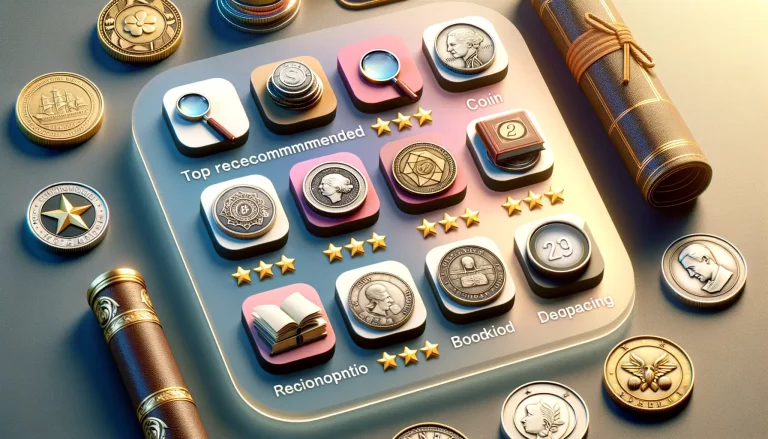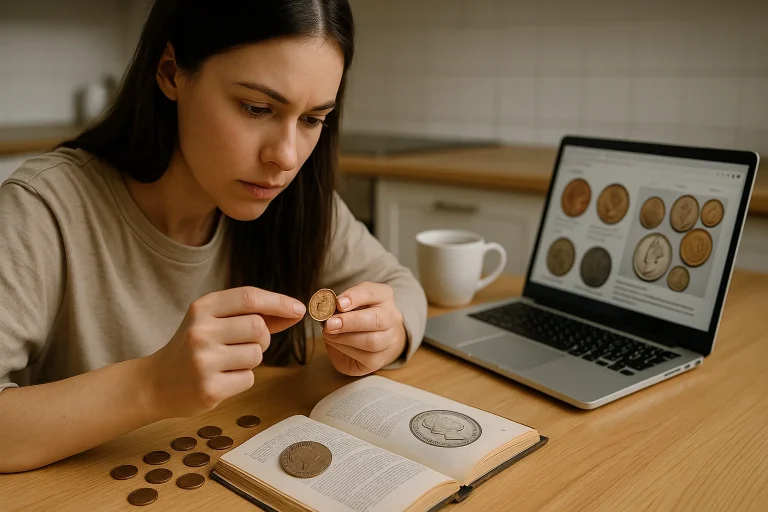The Queen Elizabeth coins value reflects more than age or metal. From early bronze pennies to modern gold sovereigns, these coins reflect seven decades of minting. Some are worth only face value, while others reach high prices due to rarity or proof quality. That is why here we discuss which coins to keep, sell, or invest in to make practical decisions.
Coins to Keep: For Beginners
Many coins with Queen Elizabeth’s portrait are common but still collectible. They show design changes across years and countries and remain affordable for new collectors. So, owning some early or well-preserved examples is a good start to learn grading and coin care.
- 1953 First Portrait Issues
The first coins after the Coronation show a young Queen Elizabeth II designed by Mary Gillick. They were struck in bronze and used across Britain, Canada, Australia, and New Zealand. These coins are easy to find and affordable, yet they are still collectible, as they mark the beginning of a new reign.
Details:
- Obverse: youthful portrait without crown.
- Reverse: traditional national symbols (wheat, animals, or denomination wreaths).
- Average value: £1 – £10 in good condition.
- Why keep: historical start of Elizabeth’s coinage; clear portrait and inscriptions remain collectible.
- 1971 Decimal Change Series
Britain switched to the decimal system in 1971. The new 1p and 2p coins showed a mature portrait of Queen Elizabeth II (offered by Arnold Machin). Most of these pieces were made in large numbers, but early uncirculated sets are still worth finding and keeping.
Useful points:
- Represents a major monetary reform.
- Affordable even in top grades (about £2–£5).
- Easy to store and display in albums.
- Canadian and Australian Cents (1950s–1970s)
These coins share the same portrait of the Queen but local design on the reverse. Collectors often start with them because they’re inexpensive and show some regional variations that can be collected as a set.
Examples:
- Canadian 1 cent 1953 – 1979 (Maple leaf reverse).
- Australian 1 cent 1953 – 1964 (Feather-tailed Glider).
- Prices range CAD $1 – $10 depending on color and wear.
Summary Table — Beginner Coins
| Coin | Country | Years | Material | Typical Value (2025) |
| 1 Penny (First Portrait) | UK | 1953–1967 | Bronze | £1–£10 |
| Decimal 2 Pence | UK | 1971–1990 | Bronze | £1–£5 |
| 1 Cent | Canada | 1953–1979 | Bronze | $1–$10 |
| 1 Cent | Australia | 1953–1964 | Bronze | $2–$12 |
These pieces are perfect learning material: low cost, good detail, and easy to identify. Collect them to learn color changes in copper and grading basics.

Coins to Sell: For Experienced Collectors
Here it comes about certain issues with limited mintage or special designs that attract steady demand. Selling them makes sense if you already have duplicates or other more valuable examples. For example, proof sets, silver jubilees, and commemorative £5 pieces often bring the best prices.
- 1953 Coronation Proof Set
The first official collector set of Queen Elizabeth II coins. Proofs have mirrored surfaces and sharp details, minted only for presentation. Around 40,000 sets were made, containing all main denominations from the farthing to the half crown. Each piece was struck on polished blanks with special dies to give the “frosted portrait” effect.
Most sets were sold in red or maroon cases and included a certificate. Over time, many were separated, so full, untampered sets are more desirable.
Market facts:
- High demand among British and Commonwealth collectors.
- Typical range £250 – £600 depending on condition and filling of the set.
- Some early pieces can also have some die differences, which also add value.
- 1977 Silver Jubilee Crown
These coins honor the 50th wedding anniversary of Queen Elizabeth II and Prince Philip. On the obverse is the standard portrait by Raphael Maklouf. The reverse depicts both their portraits side by side (offered by Philip Nathan).
Coins were struck in both cupronickel for mass use and silver proof for collectors. Over 37 million Cu-Ni pieces were made, while silver proofs were limited and had better, sharper details.
Points to know:
- Cu-Ni version £5–£15 depending on grade and packaging.
- Silver proof £40–£80, with certificates raising value slightly.
- Natural toning or rainbow color from storage can add a few pounds.
- A common but steady market coin, easy to sell and widely recognized.
- 1997 Golden Wedding £5 Proof
This coin was issued for the 50th wedding anniversary of Queen Elizabeth II and Prince Philip. The front has the usual portrait, and the back shows both of their profiles side by side (designed by Philip Nathan).
Only 25,000 silver and 1,000 gold proof coins were made, so it is one of the rarer modern £5 issues.
Details to know:
- Silver version £70–£150 depending on case, toning, and certificate.
- Gold version £1,800–£2,500+; higher prices for graded or boxed examples.
- Rarely appears in circulation; traded mostly through major auction houses.
Summary Table — Coins to Sell
| Coin | Event | Metal | Mintage | Market Range |
| 1953 Proof Set | Coronation | Bronze / Ni | ≈40 000 | £250 – £600 |
| 1977 Crown | Silver Jubilee | Cu-Ni / Ag | 37 M (Cu-Ni) | £5 – £80 |
| 1997 £5 Proof | Golden Wedding | Ag / Au | 25 000 | £70 – £2 500 |
Selling works best for proof or limited issues. Before listing, compare prices from Heritage Auctions or Stack’s Bowers. And remember to avoid cleaning — original luster sells better than shine.
Coins to Invest In: For Investors
Investment coins combine high purity metals with historical value. Gold and silver issues with Queen Elizabeth’s portrait remain stable even when markets shift. Certified bullion or low-mintage proof coins are the most reliable long-term options.
- 2022 Platinum Jubilee Coins
The last coins released during Queen Elizabeth II’s lifetime and the final ones to bear her portrait. Issued by the Royal Mint in gold, silver, and platinum to mark 70 years of the Queen on the throne — the longest reign in British history. Collectors value them for both their sharp details and symbolic meaning — they close the Queen’s coinage era before the transition to King Charles III.
Range (2025):
- Silver proof £150–£250, depending on presentation and certificate.
- Gold sovereign £450–£650, higher for graded or boxed examples.
- Platinum proof £1,000+, scarce due to small production.
- Attractive as investment-grade pieces: final portrait, certified sets, and high emotional demand keep prices stable.
- Canadian Silver Maple Leaf (Elizabeth II Obverse)
Introduced in 1988, this bullion coin became one of the most traded silver coins in the world. It shows Queen Elizabeth II on the obverse and the iconic maple leaf on the reverse.
The coin is made of 99.99% pure silver, i.e., this coin is a favorite among both collectors and investors. Early years (1988–1999) with the first portrait often bring small premiums, especially if the piece has a high grade.
Facts:
- Typical spot-based value $25–$40 depending on silver price.
- Values are high due to its global reputation and the Queen’s portrait.
- Available in 1 oz and 10 oz versions; older issues with light toning are popular among collectors.
- Recognized worldwide and easy to resell in both numismatic and bullion markets.
- Australian Gold Kangaroo and Lunar Series
Struck by the Perth Mint, these coins carry Queen Elizabeth II’s portrait on the obverse until 2023. They are among the purest gold coins in circulation (99.99% fine gold) and attract attention for their detailed wildlife and zodiac-themed designs.
The Kangaroo series changes its reverse designs every year, while the Lunar series follows the Chinese calendar. This coin attracts collectible and investment appeal.
Values (2025):
- 1/10 oz ≈ $250, depending on the gold spot.
- 1 oz ≈ $2,400, with premiums for low-mintage years.
- Limited “Lunar Year” editions or coins in original capsules often sell higher.
- The blend of art, purity, and Elizabeth II’s image keeps these coins sought-after long-term.
Summary Table — Investment Coins
| Coin | Metal | Purity | Typical Value (2025) | Demand |
| 2022 Jubilee Sovereign | Gold | 0.917 | £450 – £650 | High |
| Silver Maple Leaf | Silver | 0.9999 | $25 – $40 | Very High |
| Gold Kangaroo | Gold | 0.9999 | $250 – $2 400 | High |
Investment coins require authenticity, so buy only from authorized dealers and request mint certificates. And remember to track spot metal prices — they define long-term strategies of investing in coins.

FAQs
- Which Queen Elizabeth coins are valued more?
Proof and gold coins are the most valuable, for example, the 1953 Coronation Proof Sets and the 2022 Platinum Jubilee editions. Their low mintages, historical importance, and high-quality finish are details that explain their popularity among collectors.
- Do circulated coins have any worth?
Most everyday coins with Queen Elizabeth’s portrait are worth only their face value. The exceptions are coins with visible minting errors, unusual toning, or rare date and mint combinations. And these ones can sell for several pounds or more.
- Can I still use Queen Elizabeth coins for everyday use?
Yes, they are still legal tender in the UK and other Commonwealth countries. However, older or commemorative issues are no longer used in circulation because their collector value is higher than their face value.
- How to store coins correctly?
Keep coins in special capsules or in soft, acid-free holders. Remember to avoid PVC sleeves, humidity, and direct sunlight. When you hold them, use gloves or a soft cloth to prevent dirt from your hands and further oxidation.
- How to identify and record Queen Elizabeth coins easily?
Try a modern and reliable Coin ID Scanner app that recognizes coins from photos and shows details like year, mint mark, and composition. It also helps organize and track your collection digitally, so you are able to update records over time.
The Real Worth of Queen Elizabeth Coins
For beginners coins with Queen Elizabeth II are a good choice to learn minting nuances. Experienced collectors prefer some issues for steady demand and often fill key gaps in sets.
For investors, gold and silver versions remain a safe, tangible asset confirmed by stable global interest. In the end, the real coin’s value comes from understanding which coins deserve a place in your collection and which are better to sell — nothing more, nothing less.






